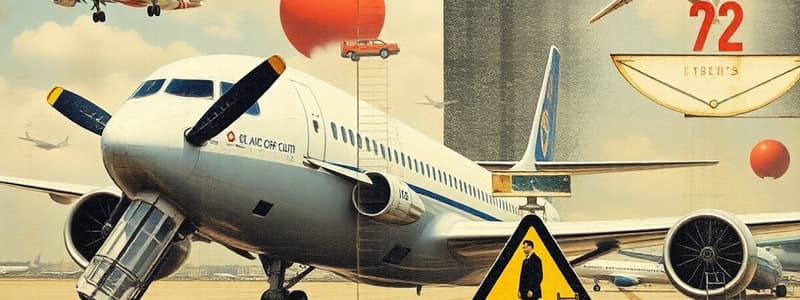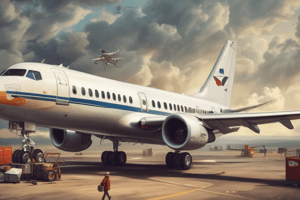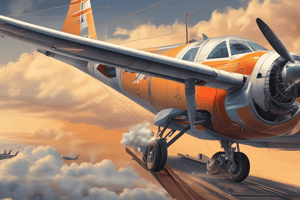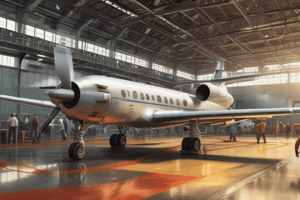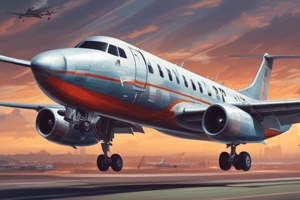Podcast
Questions and Answers
Which of the following is the MOST critical reason for maintaining good housekeeping practices in aircraft maintenance environments?
Which of the following is the MOST critical reason for maintaining good housekeeping practices in aircraft maintenance environments?
- To minimize the amount of time spent on cleaning and organizing.
- To impress visitors and clients with a clean and organized workspace.
- To comply with aesthetic standards and improve employee morale.
- To reduce the risk of accidents and ensure efficient maintenance operations. (correct)
What is the PRIMARY purpose of safety lanes in aircraft maintenance workshops and hangars?
What is the PRIMARY purpose of safety lanes in aircraft maintenance workshops and hangars?
- To designate areas for storing tools and equipment temporarily.
- To provide a clear path for visitors to tour the maintenance facilities.
- To prevent accidents between traffic (such as forklifts) and personnel. (correct)
- To serve as a decorative element enhancing the workshop's appearance.
What is the MOST appropriate action to take before working under an aircraft supported by its landing gear?
What is the MOST appropriate action to take before working under an aircraft supported by its landing gear?
- Place warning signs around the aircraft to alert other personnel.
- Verify that all landing gear down-lock safety pins are correctly installed. (correct)
- Ensure the aircraft's battery is disconnected to prevent electrical hazards.
- Inform the supervisor of your intention to work under the aircraft.
What is the MOST significant consequence of workplace accidents in aircraft maintenance, beyond immediate injuries?
What is the MOST significant consequence of workplace accidents in aircraft maintenance, beyond immediate injuries?
Why is it essential for aviation maintenance personnel to receive proper training and familiarization before operating specific equipment?
Why is it essential for aviation maintenance personnel to receive proper training and familiarization before operating specific equipment?
What BEST describes the primary aim of addressing safety precautions in aircraft maintenance workshops?
What BEST describes the primary aim of addressing safety precautions in aircraft maintenance workshops?
Besides physical injury, what is a MAJOR, less obvious, impact of neglecting safety precautions and allowing hazards to persist in aircraft maintenance environments?
Besides physical injury, what is a MAJOR, less obvious, impact of neglecting safety precautions and allowing hazards to persist in aircraft maintenance environments?
What is the MOST important reason for clearly marking and maintaining unobstructed safety lanes in a maintenance facility?
What is the MOST important reason for clearly marking and maintaining unobstructed safety lanes in a maintenance facility?
What is the primary risk if landing gear down-lock pins are not properly fitted during maintenance?
What is the primary risk if landing gear down-lock pins are not properly fitted during maintenance?
In the described incident involving the BA B787, what was the direct consequence of incorrectly inserting the NLG downlock pin?
In the described incident involving the BA B787, what was the direct consequence of incorrectly inserting the NLG downlock pin?
Why is it crucial to avoid manually turning propellers or rotors on aircraft?
Why is it crucial to avoid manually turning propellers or rotors on aircraft?
When removing aircraft floor or wing upper surface panels during maintenance, what is the purpose of covering the resulting holes with dummy panels?
When removing aircraft floor or wing upper surface panels during maintenance, what is the purpose of covering the resulting holes with dummy panels?
What is the primary hazard associated with smoking near aircraft fuel and other maintenance fluids?
What is the primary hazard associated with smoking near aircraft fuel and other maintenance fluids?
What is the MOST important reason for using down-lock pins during landing gear maintenance?
What is the MOST important reason for using down-lock pins during landing gear maintenance?
Why should personnel NEVER attempt to turn aircraft propellers or rotors by hand?
Why should personnel NEVER attempt to turn aircraft propellers or rotors by hand?
What is the significance of using dummy panels to cover openings created by removed floor or wing panels?
What is the significance of using dummy panels to cover openings created by removed floor or wing panels?
What is the primary reason for recommending specific reflectance values for surfaces in aircraft maintenance areas?
What is the primary reason for recommending specific reflectance values for surfaces in aircraft maintenance areas?
Why is it crucial to have guard rails and fences installed on workstands and platforms during aircraft maintenance?
Why is it crucial to have guard rails and fences installed on workstands and platforms during aircraft maintenance?
What critical safety measure should be taken regarding the wheels or feet of a work platform before technicians begin working on it?
What critical safety measure should be taken regarding the wheels or feet of a work platform before technicians begin working on it?
What is the most important consideration regarding the proximity of work platforms to the aircraft during maintenance activities?
What is the most important consideration regarding the proximity of work platforms to the aircraft during maintenance activities?
Prior to operating a power-operated elevating work platform, what is the most important requirement for the responsible person?
Prior to operating a power-operated elevating work platform, what is the most important requirement for the responsible person?
What is the primary hazard associated with using a naked flame as a light source in aircraft maintenance, particularly inside fuel tanks?
What is the primary hazard associated with using a naked flame as a light source in aircraft maintenance, particularly inside fuel tanks?
Why is maintaining good communication among crew members critical during aircraft maintenance operations?
Why is maintaining good communication among crew members critical during aircraft maintenance operations?
What is the primary importance of adhering to high housekeeping standards in aircraft maintenance areas?
What is the primary importance of adhering to high housekeeping standards in aircraft maintenance areas?
What immediate action should be taken if liquids are spilled in an aircraft hangar or on an aircraft?
What immediate action should be taken if liquids are spilled in an aircraft hangar or on an aircraft?
What is meant by 'loose article check'?
What is meant by 'loose article check'?
Apart from the risk of electric shock and burns, what other major hazard does electricity pose to the human body when passing through it?
Apart from the risk of electric shock and burns, what other major hazard does electricity pose to the human body when passing through it?
What specific measures should be implemented regarding electrical cables and compressed air hoses in aircraft maintenance areas to prevent accidents?
What specific measures should be implemented regarding electrical cables and compressed air hoses in aircraft maintenance areas to prevent accidents?
What is the best method to prevent Foreign Object Damage (FOD) during aircraft maintenance?
What is the best method to prevent Foreign Object Damage (FOD) during aircraft maintenance?
A bright red car appears orange under mercury vapor lamps. Which phenomenon primarily explains this color shift?
A bright red car appears orange under mercury vapor lamps. Which phenomenon primarily explains this color shift?
In the context of aircraft maintenance, why is controlling glare critical for inspectors?
In the context of aircraft maintenance, why is controlling glare critical for inspectors?
What is the fundamental difference between direct and indirect glare, and how do their control methods diverge?
What is the fundamental difference between direct and indirect glare, and how do their control methods diverge?
Which of the following strategies is LEAST effective in mitigating direct glare in an aircraft maintenance environment?
Which of the following strategies is LEAST effective in mitigating direct glare in an aircraft maintenance environment?
To minimize indirect glare, what adjustments should be made to the physical environment of an aircraft maintenance hangar?
To minimize indirect glare, what adjustments should be made to the physical environment of an aircraft maintenance hangar?
How can the reflectance of surfaces within an aircraft hangar MOST effectively enhance lighting efficiency and uniformity?
How can the reflectance of surfaces within an aircraft hangar MOST effectively enhance lighting efficiency and uniformity?
Imagine a scenario where an aircraft maintenance task requires viewing small, intricate parts. Which combination of lighting characteristics would be MOST suitable?
Imagine a scenario where an aircraft maintenance task requires viewing small, intricate parts. Which combination of lighting characteristics would be MOST suitable?
An inspector reports that a newly painted white floor in the hangar, intended to improve light reflectance, is instead causing significant glare. Analyze the MOST likely cause of this problem.
An inspector reports that a newly painted white floor in the hangar, intended to improve light reflectance, is instead causing significant glare. Analyze the MOST likely cause of this problem.
In situations where magnesium shavings are ablaze, which fire class and extinguishing method are MOST appropriate, considering the unique hazards associated with this material?
In situations where magnesium shavings are ablaze, which fire class and extinguishing method are MOST appropriate, considering the unique hazards associated with this material?
Why is using an unapproved torch during aircraft maintenance a significant fire risk, according to fire prevention guidelines?
Why is using an unapproved torch during aircraft maintenance a significant fire risk, according to fire prevention guidelines?
When dealing with a fire involving titanium dust, which presents a high-intensity hazard, what is the MOST effective extinguishing approach that addresses the unique risks associated with such finely divided metals?
When dealing with a fire involving titanium dust, which presents a high-intensity hazard, what is the MOST effective extinguishing approach that addresses the unique risks associated with such finely divided metals?
In an electrical fire within an aircraft's fuse box, why is it critical to use a non-conductive extinguishing agent?
In an electrical fire within an aircraft's fuse box, why is it critical to use a non-conductive extinguishing agent?
If a fire involves both flammable liquids and electrical equipment, which extinguishing agent offers the SAFEST and MOST effective solution, considering the dual hazards?
If a fire involves both flammable liquids and electrical equipment, which extinguishing agent offers the SAFEST and MOST effective solution, considering the dual hazards?
What is the MOST important reason for clearly differentiating fire extinguishers by color and labeling?
What is the MOST important reason for clearly differentiating fire extinguishers by color and labeling?
How does foam extinguishants work to suppress a fire?
How does foam extinguishants work to suppress a fire?
What is the PRIMARY mechanism by which water extinguishers suppress a fire?
What is the PRIMARY mechanism by which water extinguishers suppress a fire?
Flashcards
Human Carelessness
Human Carelessness
Accidents in the workplace often result from neglect and oversight.
PPE Importance
PPE Importance
Personal Protection Equipment is essential for safety in hazardous environments.
Proper Tool Use
Proper Tool Use
Only operate tools that you have trained with and understand how to use effectively.
Housekeeping in Workshops
Housekeeping in Workshops
Signup and view all the flashcards
Safety Lanes
Safety Lanes
Signup and view all the flashcards
Obstructed Safety Lanes
Obstructed Safety Lanes
Signup and view all the flashcards
Landing Gear Safety
Landing Gear Safety
Signup and view all the flashcards
Accident Prevention Legislation
Accident Prevention Legislation
Signup and view all the flashcards
Landing Gear Down-lock Pins
Landing Gear Down-lock Pins
Signup and view all the flashcards
Nose Landing Gear (NLG)
Nose Landing Gear (NLG)
Signup and view all the flashcards
Incorrect Pin Insertion
Incorrect Pin Insertion
Signup and view all the flashcards
Functional Check of NLG Doors
Functional Check of NLG Doors
Signup and view all the flashcards
Propeller Safety
Propeller Safety
Signup and view all the flashcards
Dummy Panels on Aircraft
Dummy Panels on Aircraft
Signup and view all the flashcards
Flammable Aircraft Fuels
Flammable Aircraft Fuels
Signup and view all the flashcards
Smoking Hazard in Maintenance
Smoking Hazard in Maintenance
Signup and view all the flashcards
Guard Rails
Guard Rails
Signup and view all the flashcards
Locking Workstands
Locking Workstands
Signup and view all the flashcards
Approved Lighting
Approved Lighting
Signup and view all the flashcards
Good Communication
Good Communication
Signup and view all the flashcards
Housekeeping
Housekeeping
Signup and view all the flashcards
Loose Article Check
Loose Article Check
Signup and view all the flashcards
Foreign Object Damage (FOD)
Foreign Object Damage (FOD)
Signup and view all the flashcards
Electrical Safety
Electrical Safety
Signup and view all the flashcards
Surface Reflectance Values
Surface Reflectance Values
Signup and view all the flashcards
Workstands Function
Workstands Function
Signup and view all the flashcards
Guard Rails Requirement
Guard Rails Requirement
Signup and view all the flashcards
Locking Platforms
Locking Platforms
Signup and view all the flashcards
Power-Operated Platform Training
Power-Operated Platform Training
Signup and view all the flashcards
Color perception
Color perception
Signup and view all the flashcards
Light source composition
Light source composition
Signup and view all the flashcards
Glare
Glare
Signup and view all the flashcards
Direct glare
Direct glare
Signup and view all the flashcards
Indirect glare
Indirect glare
Signup and view all the flashcards
Controlling glare
Controlling glare
Signup and view all the flashcards
Surface reflectance
Surface reflectance
Signup and view all the flashcards
High reflectance surfaces
High reflectance surfaces
Signup and view all the flashcards
Class C Fires
Class C Fires
Signup and view all the flashcards
Class D Fires
Class D Fires
Signup and view all the flashcards
Cooling Method
Cooling Method
Signup and view all the flashcards
Smothering Method
Smothering Method
Signup and view all the flashcards
Straving Method
Straving Method
Signup and view all the flashcards
Water Fire Extinguisher
Water Fire Extinguisher
Signup and view all the flashcards
Foam Fire Extinguisher
Foam Fire Extinguisher
Signup and view all the flashcards
Carbon Dioxide Extinguisher
Carbon Dioxide Extinguisher
Signup and view all the flashcards
Study Notes
Aircraft Maintenance Practices - Safety Precautions
- Accidents in the workplace, primarily caused by human carelessness, result in significant loss of man-hours and substantial financial costs for companies and individuals.
- Personnel must be aware of potential accidents, injuries, and relevant legislation to effectively prevent accidents.
- Aircraft, by design, present a demanding and dangerous work environment compounded by the variety of tools and materials required.
- Personal Protective Equipment (PPE) is essential for safety, including eye, ear, and other protective gear used whenever necessary.
- Engineers/technicians should only operate equipment they are trained and familiar with, maintaining tools and ensuring good housekeeping in workshops, hangars, and flight line ramps for efficient maintenance.
Safety Lanes
- Clearly marked safety lanes and pedestrian/fire lanes on workshops and hangar floors prevent accidents between personnel and mobile equipment (forklifts, golf carts, trolleys).
- Safety lanes must never be obstructed, ensuring clear pathways for all personnel.
Landing Gear
- Never work underneath an aircraft unless all landing gear down-lock safety pins are securely in place.
- Failure to secure the pins poses a significant risk of the aircraft falling on personnel.
- Each landing gear assembly should have one pin in place.
Nose Landing Gear Retraction
- Inadvertent retraction of the nose landing gear during ground maintenance can cause damage to the lower front section of the aircraft.
- Correctly cycling the landing gear and securing the downlock pins prevent accidental retraction.
Propellers and Rotors
- Never attempt to manually turn propellers or rotors in aircraft.
- Propeller and rotor movement might be misrepresented by lighting, particularly at night.
- Due to the apparent lack of movement, personnel may put themselves at risk of harm from moving parts/equipment.
Aircraft Floor and Wing Upper Surface Panels
- Ensure all holes in the aircraft floor or wing upper panels are covered with dummy panels to prevent personnel falling into them.
- Aircraft's maintenance fluids are highly flammable.
- Cigarettes are a prominent hazard and can spark fires that would lead to explosions.
Workstands and Platforms
- Properly erect guardrails and fences on workstands and platforms to prevent falls.
- Secure the feet and wheels of the platform to prevent movement during operation.
- Platforms should be positioned close enough to the aircraft to avoid personnel falling into gaps between the aircraft and stand.
Lighting
- Use approved, gas-proof torches or flashlights, not naked flames, for tasks within fuel tanks or potentially flammable areas.
- Insufficient lighting causes glare, shadows and reflections which hinder inspection quality.
- 75-100 foot-candles (≈800-1000 lux) is a standard lighting level for most maintenance inspection.
Noise
- Use ear defenders or earplugs in noisy environments like hangars and flight lines.
- Excessive noise (85dB(A) or greater for an extended period) can result in significant hearing damage.
High-Pressure Gases
- Always wear eye protection when working with compressed gases.
- Confirm the identity of any gas cylinder before use.
- Secure caps when storing or moving compressed gas cylinders.
- Securely attach large cylinders to trolleys/vehicles before moving.
Housekeeping
- Maintain a clean and tidy work area to minimize accident risks.
- Keep tools/materials for a task organized close to the working area to avoid wide area spread out.
- Perform a thorough loose article check before completing the task and locking up.
- Clean any spilled liquids in the aircraft and hangar area immediately.
- Properly store aircraft parts and tools, keeping cables and compressed hoses laid out neatly, preventing tripping hazards.
Fire Safety and Prevention
- Fires involve three elements (fuel, oxygen, heat), removing any one element stops the fire.
- Four classes of fires are established based on the type of material (A, B, C, D).
- Appropriate fire extinguishers must be used according to the class of fire.
- Fire extinguishers differ in color and contents according to their type of extinguishing agent (Water, Foam, Carbon Dioxide, Halon/BCF, Chemical Dry Powder).
- Prohibited activities in airplane maintenance areas to prevent fire include smoking, incorrect use of torches/lights and disposal of materials.
- Avoid overloading electrical outlets.
Work at Heights Guidance
- Secure work platforms' feet and wheels to prevent movement during use.
- Platforms should be close enough on aircraft to avoid personnel falling through gaps or into the air.
- Any personnel operating power-operated elevating work platforms should receive necessary training and observe all safety precautions prior and during operations.
Studying That Suits You
Use AI to generate personalized quizzes and flashcards to suit your learning preferences.
